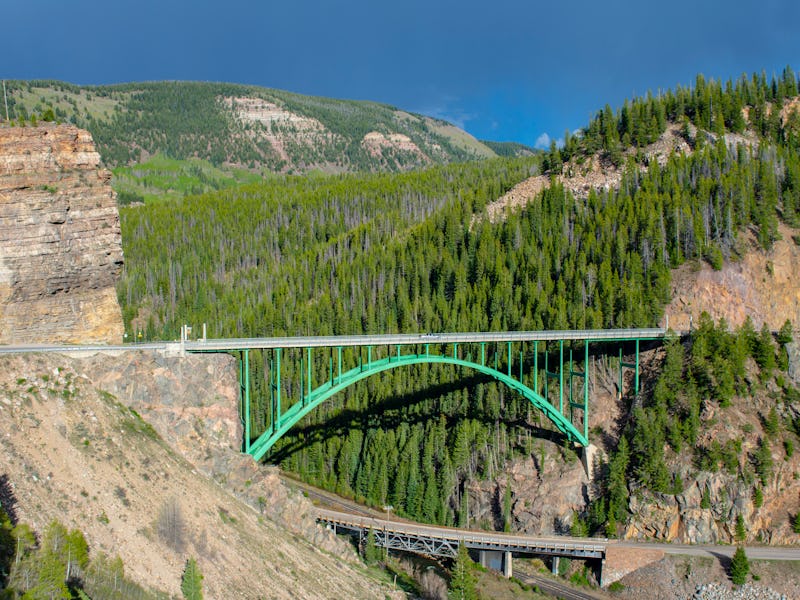This amazing material could solve your commute's biggest problem
Tiny ice crystals were once concrete's Achilles heel, but no longer.

Concrete makes up much of the world around us -- from sidewalks and roads to towering office buildings -- but this omnipresent behemoth has one big Achilles heel: tiny ice crystals.
These crystals can cause big cracks in this otherwise strong material and make it mechanically weak and even dangerous to drive or walk near. To solve this problem scientists have turned to an unlikely source of inspiration -- fish, plants, and bacteria.
By studying ice-resistant proteins of bacteria designed to survive at sub-zero temperatures, researchers were able to create polymers that act as a natural anti-freeze when mixed with concrete. With this polymer, the scientists observed a 90 percent decrease in ice crystal size without any loss in strength.
While concrete looks like an impenetrable material from the outside, on the inside it's actually full of many little holes called pores. When it gets too cold, the pores of this material are infiltrated by tiny ice crystals and build-up pressure under the surface as the ice expands, sending splintering cracks through these tough materials, sometimes called frost heaves.
That's bad news not only for cars trying to drive over these ruined roads, but also because the production of a key chemical in cement already accounts for nearly nine percent of the world's CO2 emissions and experts estimate that the production of cement will grow another 50 percent by 2050 to meet demands. Leaving this problem unaddressed could not only cost a lot of money but could damage our environment too.
"In our view, it's a quantum leap in the right direction and opens the door for brand new admixture technologies."
Part of what makes this innovation so exciting, write the authors of a new paper published this week in Cell is that it's a steep departure from concrete technology that had been used for the past 70 years.
"We're particularly excited because this represents a departure away from more than 70 years of conventional concrete technology," senior author and head of the Living Materials Laboratory at the University of Colorado Boulder, Wil Srubar said in a statement. "In our view, it's a quantum leap in the right direction and opens the door for brand new admixture technologies."
Ice crystals that bind with the bioinspired polymer experience dynamic ice shaping, changing from a sphere to a rounded hexagon. The researchers call this 'lemon ice'.
Before the new anti-freeze polymers described in this study, concrete used to fight back against these ice crystals using something called "air-entraining admixtures" (AEAs.) Essentially, instead of targeting the ice crystals themselves -- as this new approach does -- AEAs worked to release pressure in the concrete's pores. But, while this worked to some degree, the tiny air bubbles the AEAs put into the concrete also made it weaker and more susceptible to damaging materials, like water and salt, entering its pores.
Sufficed to say, concrete needed a better solution.
By synthesizing two different kinds of bacteria, engineers from the University of Colorado Boulder behind this new study were able to isolate two important proteins responsible for "ice-binding" and "dynamic ice shaping." In living organisms, these proteins bind to emerging ice crystals and halt their growth. This helps keep living organisms alive in frigid weather. The researchers hypothesized that this approach could also keep dangerous ice crystals from forming in the concrete as well.
"For the next 30 years, the world will be building a New York City every 35 days."
To mimic these proteins, the researchers designed a polymer called polyethylene glycol-graft-polyvinyl alcohol (PEG-PVA) and introduced it to their concrete paste. They then turned the temperature way down to negative four degrees Fahrenheit and cycled through 300 freeze-thaw periods. By the end, the team observed that ice crystal formations had decreased in size by 90 percent without losing any of the concrete's strength.
If concrete is like a cake batter, the researchers say that this additive could represent a delicious new recipe and one that could secure the safety and effectiveness of concrete for years to come.
"For the next 30 years, the world will be building a New York City every 35 days, which is astounding," says Srubar. "What that means is that we're going to be building a lot of buildings and roads, and we're going to be using a lot of concrete. Because it has significant impacts on the environment, the concrete that we do make really does have to be as sustainable as possible and as durable as it can be."
Abstract: Since the 1930s, surfactant-based air-entraining admixtures (AEAs) have been used to mitigate freeze-thaw damage in cementitious materials. While effective, entrained air voids weaken concrete and increase its permeability, thereby increasing susceptibility to multiple other forms of in situ degradation. Inspired by nature, we report that a soluble biomimetic antifreeze polymer that displays ice recrystallization inhibition (IRI) and dynamic ice shaping (DIS) activities can prevent damage from ice crystal growth in cement paste and concrete. We first report that polyethylene glycol-graft-polyvinyl alcohol (PEG-PVA) mimics the explicit IRI and DIS activity of native ice-binding proteins in high-pH media characteristic of concrete pore solution. Second, we report that addition of PEG-PVA to cement paste and concrete prevents freeze-thaw damage without entraining air. Taken together, the findings demonstrate an alternative mechanistic approach to AEAs that can be leveraged to prevent damage from ice crystal growth in cementitious materials.